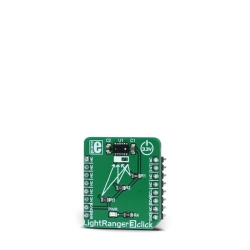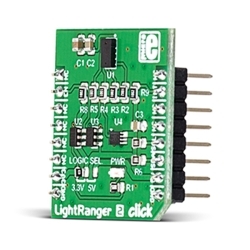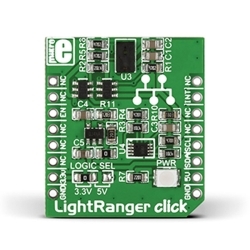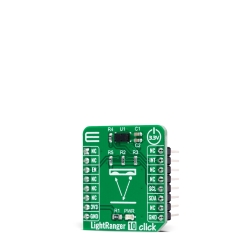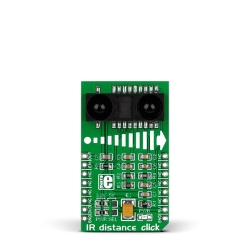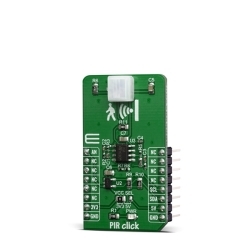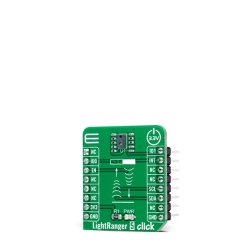MIKROE LightRanger 9 Click
LightRanger 9 Click is a compact add-on board suitable for range-finding and distance sensing applications.
Product Overview
LightRanger 9 Click is a compact add-on board suitable for range-finding and distance sensing applications. This board features the TMF8828, a dToF (direct time of flight) optical distance sensor with an integrated Vertical Cavity Surface Emitting Laser (VCSEL) achieving up to 5m target detection distance from ams AG. Due to its lens on the SPAD, it supports 3x3, 4x4, 3x6, and 8x8 multizone output data and a wide, dynamically adjustable field of view. All raw data processing is performed inside the TMF8828, providing distance information and confidence values through its I2C interface. A unique addition to this Click board™ represents an additional 0.7mm thick protective lens that further reduces interference and improves the sensor's accuracy. This Click board™ is suitable for presence (object) detection, distance measurement, industrial ranging, inventory control, and many other applications.
LightRanger 9 Click as its foundation uses the TMF8801, a dToF wide field of view optical distance sensor module with multizone from ams AG. This sensor is built using a single-photon avalanche diode (SPAD) array, time-to-digital converter (TDC), and histogram technology featuring an associated VCSEL, while the high-quality lens on the SPAD supports a dynamically adjustable field of view up to 63°. The TMF8828 detects the target area in multiple zones with precise measurement results, with a minimum distance of 10mm and a maximum of 5m. It can also detect numerous objects per zone, allowing automated robots to gain additional sensory awareness and provide early alerts to potential obstacles.
The TMF8828 operating principle uses a pulse train of VCSEL pulses defined by the iteration setting. These pulses are spread using an MLA (microlens array) to illuminate the FoI (illumination field). An object reflects these rays to the TMF8828 receiver optics lens and onto an array of SPAD (single-photon avalanche detector). A TDC (time to digital converter) measures the time from the emission of these pulses to their arrival and accumulates the hits into bins inside a histogram. As mentioned before, the TMF8828 comes with a multizone operation.
It has two operating modes, a mode with 3x3, 4x4, or 3x6 zones, or 8x8 zones, which implements its functionality as a sequence of four time-multiplexed measurements of 4x4 zones. As such, the factory calibration sequence, loading the calibration data, reading the result measurements, and the optional histogram readouts must be performed four times in series by the host. Also, unique addition to this Click board™ represents an additional 0.7mm thick protective lens, alongside a 0.38mm air-gap spacer that separates the lens from the sensor, further reducing interference and improving the sensor's accuracy.
LightRanger 9 Click communicates with MCU using the standard I2C 2-Wire interface supporting Fast Mode operation with a clock frequency of 1MHz. It provides distance information together with confidence values through its serial interface. The internal processor of the TMF8828 (ARM M0+®) executes the AMS algorithm on these histograms, to calculate the target distance of the object presented in mm through the I2C interface for each of the zones.
Also, it provides the possibility of the device Power-Up feature (Enable) routed to the CS pin of the mikroBUS™ socket, interrupt feature on the INT pin of the mikroBUS™ to optimize ranging operation, and two pins on the RST and PWM pins of the mikroBUS™ socket used as general-purpose I/O signals.
This Click board™ can be operated only with a 3.3V logic voltage level. The board must perform appropriate logic voltage level conversion before using MCUs with different logic levels. However, the Click board™ comes equipped with a library containing functions and an example code that can be used, as a reference, for further development.
Features & Specs
- Interface: I2C
- Compatibility: mikroBUS™
- Dimensions: 42.9 x 25.4mm
- Input Voltage: 3.3V
- Distance Measurement Range: Min. 10mm, Max. 5000mm
- Field of View: 63 Deg
- VCSEL Wavelength: 940nm
- Operating Temperature Range: Min. -30°C, Typ. +25°C, Max. +70°C
Documentation
Customer Reviews
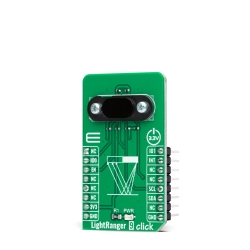
Stock and Customer Discounts
Available Discounts
- $37.95 | 25+ units
- $35.96 | 100+ units


